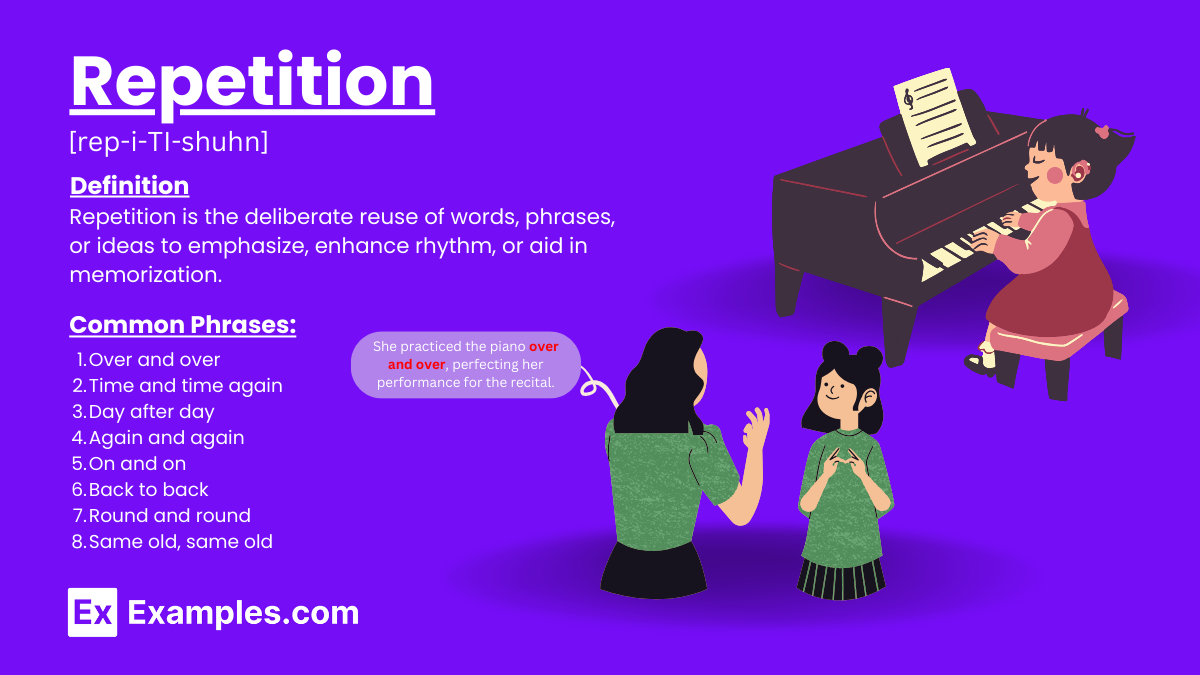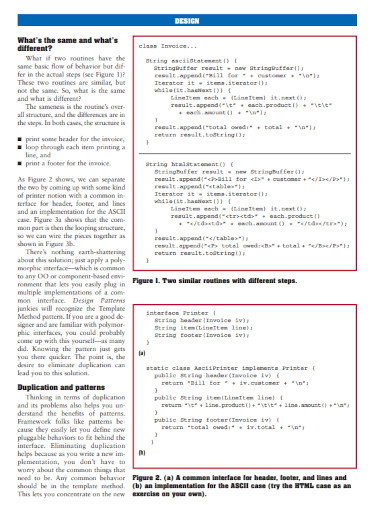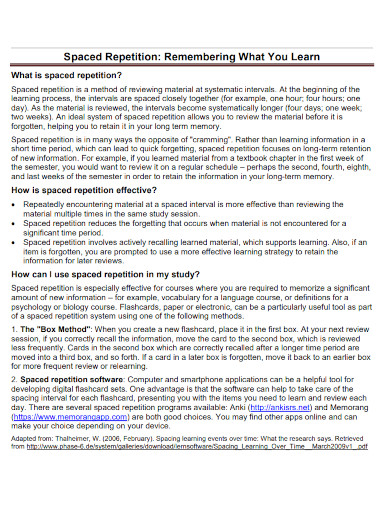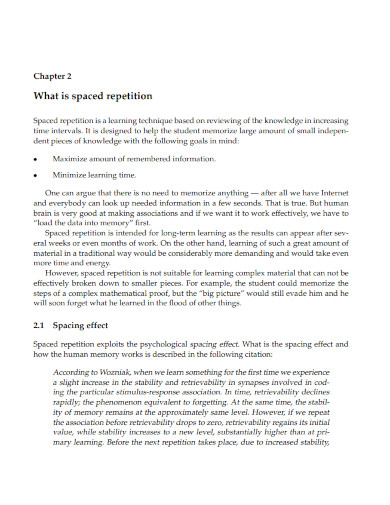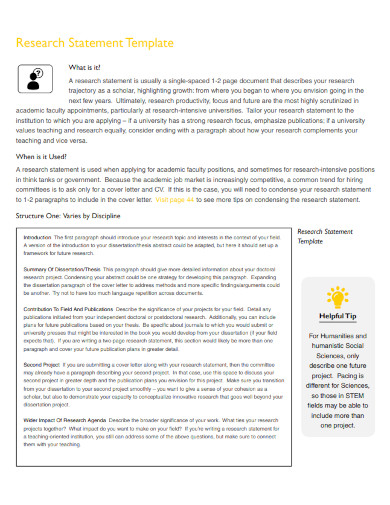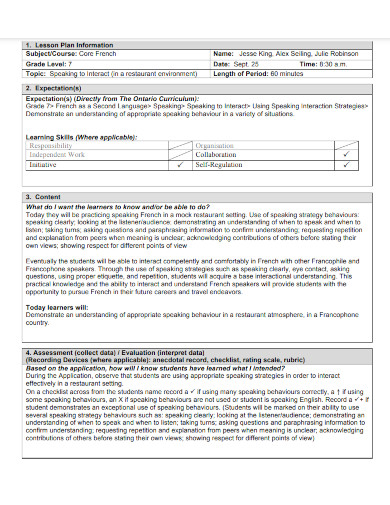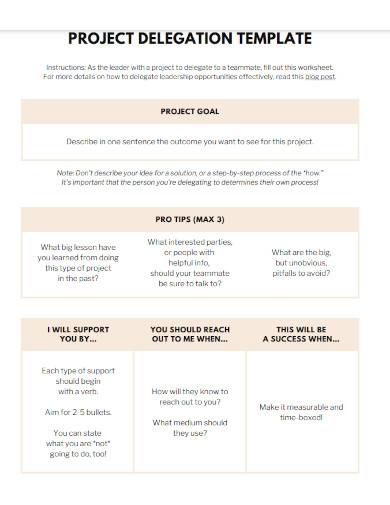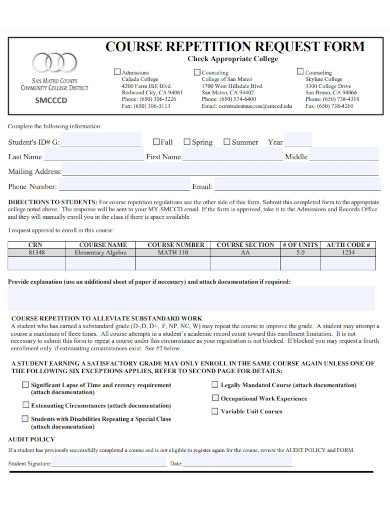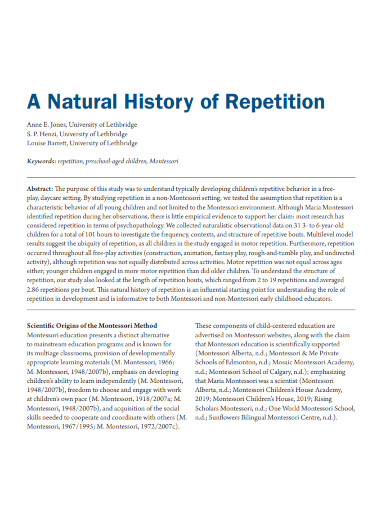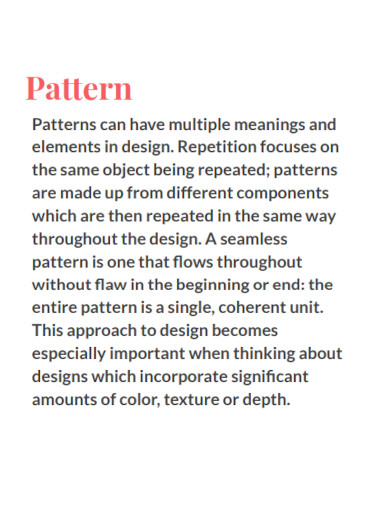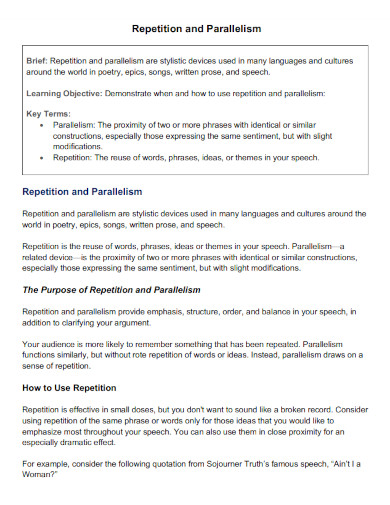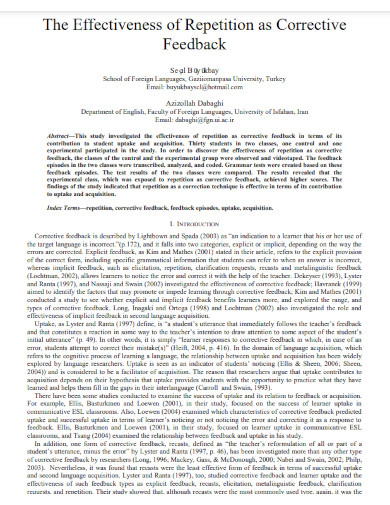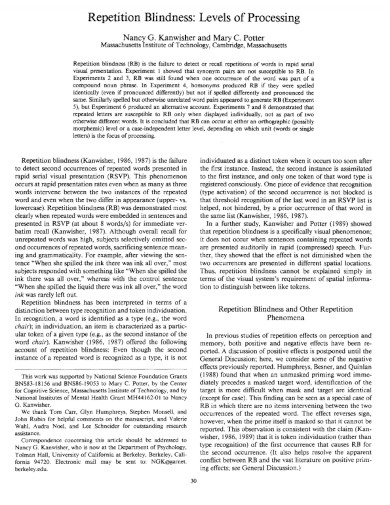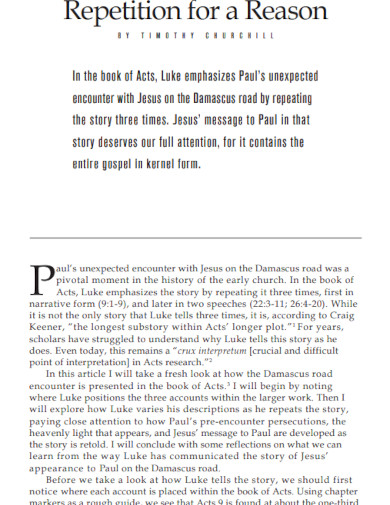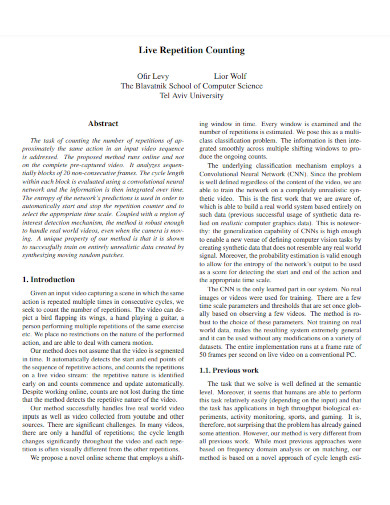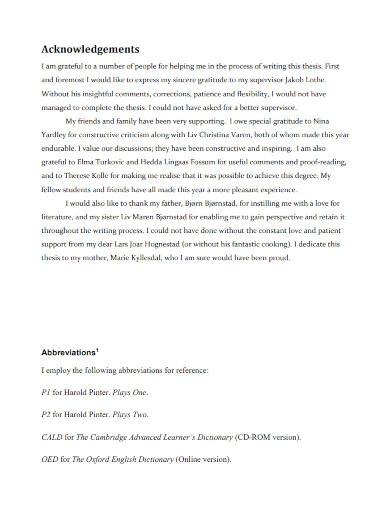60+ Repetition Examples
Repetition is a powerful literary and rhetorical device where words, phrases, or structures are deliberately repeated to emphasize key points, create rhythm, or enhance meaning. By using repetition, writers and speakers can make their message more memorable and impactful. This technique is commonly found in poetry, speeches, and prose, helping to reinforce themes and engage audiences through familiar patterns.
The Christmas song “Jingle Bells” has lyrics that repeat the words jingle and bells in succession. The repeating creates a specific melody and musicality in the song. The technique used in the lyrics of “Jingle Bells” is called repetition.
What Is Repetition?
Repetition is a technique used by writers, poets, and artists in their artistic outputs. This technique requires the user to repeat specific words, phrases, and patterns in their work. The advantage of using repetition in your output is that you can emphasize a certain point or create a new meaning that would otherwise be very difficult to achieve.
What is Repetition in Poetry?
Repetition in poetry is a powerful literary device where poets intentionally reuse words, phrases, lines, or stanza to create a rhythmic pattern, emphasize key themes, and enhance the overall meaning of the poem. This technique serves several purposes:
- Creating Rhythm: Repetition can establish a rhythmic flow, making the poem more musical and engaging. This rhythm can evoke different emotions and set the tone of the poem.
- Emphasizing Themes: By repeating specific words or phrases, poets can highlight the central themes or messages they want to convey. This emphasis ensures that these ideas stand out to the reader.
- Enhancing Meaning: Repetition can deepen the meaning of the poem by adding layers of significance to the repeated elements. It can draw connections between different parts of the poem, creating a more cohesive and resonant piece.
- Evoking Emotions: The rhythmic and emphatic nature of repetition can evoke strong emotional responses from readers. It can create a sense of urgency, passion, or contemplation, depending on how it is used.
- Creating Structure: Repetition can provide a structural framework for a poem, giving it a sense of unity and coherence. This structure can help guide the reader through the poem and reinforce its overall impact.
Types of Repetition
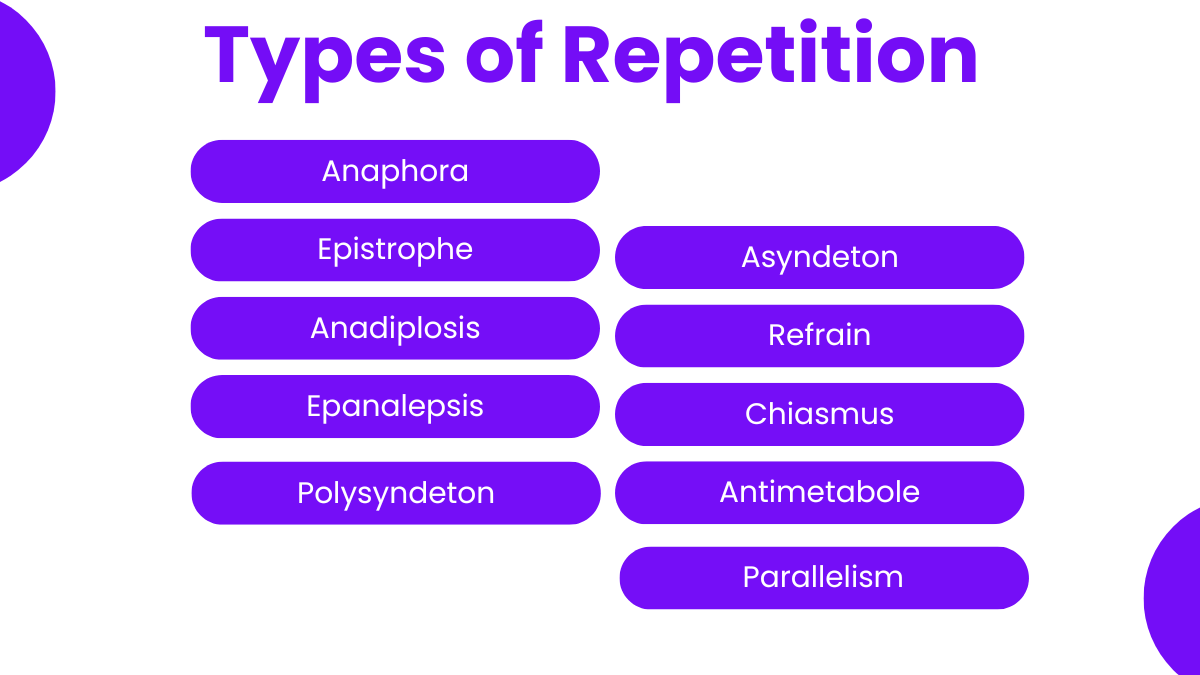
1. Anaphora Anaphora is the repetition of a word or phrase at the beginning of successive clauses, sentences, or lines. It is often used to create emphasis and build a sense of rhythm.
Example: “We shall fight on the beaches, we shall fight on the landing grounds, we shall fight in the fields and in the streets…” – Winston Churchill
2. Epistrophe Epistrophe is the repetition of a word or phrase at the end of successive clauses, sentences, or lines. It often creates a dramatic effect.
Example: “…of the people, by the people, for the people, shall not perish from the earth.” – Abraham Lincoln
3. Anadiplosis Anadiplosis is the repetition of the last word of one clause or sentence at the beginning of the next. It can create a sense of continuity and progression.
Example: “The love of wicked men converts to fear, that fear to hate, and hate turns one or both to worthy danger and deserved death.” – William Shakespeare
4. Epanalepsis Epanalepsis is the repetition of a word or phrase at both the beginning and the end of a clause or sentence. This technique emphasizes the repeated word or phrase.
Example: “Next time there won’t be a next time.” – Phil Leotardo in The Sopranos
5. Polysyndeton Polysyndeton is the repetition of conjunctions in close succession. It can slow the rhythm of the text and add a sense of multiplicity or build-up.
Example: “They read and studied and wrote and drilled. I laughed and played and talked and flunked.” – William F. Buckley, Jr.
6. Asyndeton Asyndeton is the omission of conjunction between parts of a sentence. It can create a fast-paced, dramatic effect.
Example: “I came, I saw, I conquered.” – Julius Caesar
7. Refrain A refrain is a phrase or line repeated at intervals within a poem or song, often at the end of a stanza. It emphasizes a central theme or idea.
Example: “Quoth the Raven, ‘Nevermore.'” – Edgar Allan Poe
8. Chiasmus Chiasmus is the repetition of ideas or grammatical structures in inverted order. It creates a mirror-like effect.
Example: “Never let a Fool Kiss You or a Kiss Fool You.”
9. Antimetabole Antimetabole is a type of chiasmus where the repetition of words is in reverse order, creating a contrasting effect.
Example: “Ask not what your country can do for you — ask what you can do for your country.” – John F. Kennedy
10. Parallelism Parallelism is the repetition of similar grammatical structures in successive clauses or sentences. It adds balance and rhythm.
Example: “Like father, like son.”
Examples of Repetition
Repetition Examples in Literature
Repetition is a literary device where words, phrases, or sentences are repeated to emphasize a point, create rhythm, or build tension. Here are some examples of repetition in literature:
- “A Tale of Two Cities” by Charles Dickens:
- Opening lines: “It was the best of times, it was the worst of times, it was the age of wisdom, it was the age of foolishness…”
- The repeated structure emphasizes the contradictions and complexities of the era.
- “The Raven” by Edgar Allan Poe:
- Repetition of “Nevermore.”
- The refrain “Nevermore” builds a haunting and melancholic atmosphere throughout the poem.
- “I Have a Dream” by Martin Luther King Jr. (not strictly literature, but a powerful use of repetition in a speech):
- Repetition of “I have a dream.”
- The repeated phrase emphasizes the vision and hope for racial equality and justice.
- “The Catcher in the Rye” by J.D. Salinger:
- Repetition of “phony.”
- The frequent use of the word “phony” by Holden Caulfield emphasizes his disdain for the superficiality he perceives in the world around him.
- “Howl” by Allen Ginsberg:
- Repetition of “who” in the opening lines: “I saw the best minds of my generation destroyed by madness, starving hysterical naked, dragging themselves through the negro streets at dawn looking for an angry fix…”
- The repeated use of “who” creates a rhythmic flow and emphasizes the collective suffering and search for meaning.
- “The Bells” by Edgar Allan Poe:
- Repetition of “bells, bells, bells.”
- The repetition mimics the ringing of bells and enhances the poem’s musical quality.
- “Song of Myself” by Walt Whitman:
- Repetition of “I celebrate myself, and sing myself.”
- The repeated structure throughout the poem emphasizes the themes of individuality and self-exploration.
- “Macbeth” by William Shakespeare:
- Repetition of “Tomorrow, and tomorrow, and tomorrow.”
- The repetition in Macbeth’s soliloquy underscores the monotony and futility of life.
- “The Road Not Taken” by Robert Frost:
- Repetition of “I doubted if I should ever come back.”
- The repetition emphasizes the significance of the speaker’s choice and the finality of decisions.
- “Green Eggs and Ham” by Dr. Seuss:
- Repetition of “I do not like green eggs and ham.”
- The repeated phrase throughout the book creates a rhythmic and engaging narrative for young readers.
Repetition Examples in Poetry
Repetition is a powerful tool in poetry, used to emphasize themes, create rhythm, and evoke emotion. Here are some notable examples of repetition in poetry:
- “The Raven” by Edgar Allan Poe:
- Repetition of “Nevermore.”
- The word “Nevermore” is repeated by the raven, creating a haunting refrain that emphasizes the poem’s dark, melancholic tone.
- “Do Not Go Gentle into That Good Night” by Dylan Thomas:
- Repetition of “Do not go gentle into that good night” and “Rage, rage against the dying of the light.”
- These repeated lines form a villanelle structure, reinforcing the poem’s urgent plea to resist death.
- “Stopping by Woods on a Snowy Evening” by Robert Frost:
- Repetition of “And miles to go before I sleep.”
- The repeated line at the end underscores the speaker’s sense of duty and the journey ahead.
- “The Tyger” by William Blake:
- Repetition of “Tyger Tyger, burning bright.”
- The opening and closing lines frame the poem, emphasizing the central image of the tiger and its fierce, mysterious nature.
- “I Hear America Singing” by Walt Whitman:
- Repetition of “singing.”
- The word “singing” is repeated to celebrate the diverse, vibrant voices of America’s working people.
- “Annabel Lee” by Edgar Allan Poe:
- Repetition of “In this kingdom by the sea.”
- The repeated phrase creates a lyrical, almost hypnotic quality, enhancing the poem’s romantic and mournful tone.
- “If—” by Rudyard Kipling:
- Repetition of “If you can…”
- The repeated conditional phrases build up to the poem’s inspirational message about personal integrity and resilience.
- “We Real Cool” by Gwendolyn Brooks:
- Repetition of “We.”
- The repeated “We” at the beginning of each line creates a rhythmic, chant-like effect, emphasizing the collective identity of the poem’s subjects.
- “O Captain! My Captain!” by Walt Whitman:
- Repetition of “O Captain! My Captain!”
- The repeated exclamation mourns the death of Abraham Lincoln and highlights the poem’s elegiac tone.
- “Mad Girl’s Love Song” by Sylvia Plath:
- Repetition of “I shut my eyes and all the world drops dead.”
- The repeated line underscores the speaker’s emotional intensity and sense of disorientation.
Repetition Examples Sentences
Repetition in sentences can emphasize a point, create rhythm, or enhance the emotional impact. Here are some examples of repetition in sentences:
- From “I Have a Dream” by Martin Luther King Jr.:
- “I have a dream that one day this nation will rise up and live out the true meaning of its creed: ‘We hold these truths to be self-evident, that all men are created equal.’ I have a dream that one day on the red hills of Georgia, the sons of former slaves and the sons of former slave owners will be able to sit down together at the table of brotherhood.”
- From “A Tale of Two Cities” by Charles Dickens:
- “It was the best of times, it was the worst of times, it was the age of wisdom, it was the age of foolishness…”
- From “The Bells” by Edgar Allan Poe:
- “To the swinging and the ringing of the bells, bells, bells, of the bells, bells, bells, bells, bells, bells, bells.”
- From “O Captain! My Captain!” by Walt Whitman:
- “But O heart! heart! heart! / O the bleeding drops of red, / Where on the deck my Captain lies, / Fallen cold and dead.”
- From “The Gettysburg Address” by Abraham Lincoln:
- “We cannot dedicate—we cannot consecrate—we cannot hallow—this ground.”
- From “Macbeth” by William Shakespeare:
- “Tomorrow, and tomorrow, and tomorrow, creeps in this petty pace from day to day…”
- From “The Charge of the Light Brigade” by Alfred Lord Tennyson:
- “Cannon to right of them, / Cannon to left of them, / Cannon in front of them / Volleyed and thundered…”
- From “Howl” by Allen Ginsberg:
- “Who poverty and tatters and hollow-eyed and high sat up smoking in the supernatural darkness of cold-water flats floating across the tops of cities contemplating jazz…”
- From “Because I Could Not Stop for Death” by Emily Dickinson:
- “We passed the School, where Children strove / At Recess—in the Ring— / We passed the Fields of Gazing Grain— / We passed the Setting Sun—”
- From “The Old Man and the Sea” by Ernest Hemingway:
- “He was an old man who fished alone in a skiff in the Gulf Stream and he had gone eighty-four days now without taking a fish.”
Repetition Examples for Students
Repetition can be an effective tool for students to understand and use in their writing. Here are some examples of repetition in sentences that students can relate to and learn from:
- Classroom Example:
- “Every day, we learn something new. Every day, we grow a little wiser. Every day, we get closer to our goals.”
- Repetition of “Every day” emphasizes the consistency and importance of daily learning.
- Sports Motivation:
- “Practice, practice, practice—that’s the key to success in any sport. Practice makes perfect.”
- Repetition of “practice” stresses the importance of regular training and effort.
- Encouragement:
- “You can do it! You can do it! You can do it!”
- Repetition of “You can do it” builds confidence and encouragement.
- Environmental Awareness:
- “Reduce, reuse, recycle. Reduce, reuse, recycle. Reduce, reuse, recycle.”
- Repetition of the three R’s reinforces the message of environmental responsibility.
- Study Reminder:
- “Read your notes, read your textbook, and read your assignments. Reading helps you understand and remember the material.”
- Repetition of “read” emphasizes the importance of thorough preparation.
- Friendship:
- “A true friend is always there for you. A true friend listens to you. A true friend supports you.”
- Repetition of “A true friend” highlights the qualities of a good friendship.
- Time Management:
- “Plan your time, manage your time, and respect your time. Time is valuable.”
- Repetition of “time” emphasizes the importance of time management skills.
- Healthy Habits:
- “Eat well, sleep well, and exercise regularly. Eat well, sleep well, and exercise regularly.”
- Repetition of healthy habits reinforces the importance of a balanced lifestyle.
- Positive Thinking:
- “Think positive, be positive, and act positive. Positive thinking leads to positive outcomes.”
- Repetition of “positive” encourages an optimistic mindset.
- Perseverance:
- “Keep trying, keep pushing, and keep believing. Success comes to those who persist.”
- Repetition of “keep” emphasizes the importance of perseverance.
Repetition Examples in Songs
Repetition in songs can create a catchy rhythm, emphasize key themes, and enhance the emotional impact. Here are some notable examples of repetition in songs:
- “Let It Be” by The Beatles:
- “Let it be, let it be, let it be, let it be / Whisper words of wisdom, let it be”
- The repeated phrase “let it be” reinforces the song’s message of acceptance and comfort.
- “Hey Jude” by The Beatles:
- “Na-na-na-na-na-na-na, na-na-na-na, hey Jude”
- The repeated “na-na-na” and “hey Jude” create a memorable and singable refrain.
- “Shake It Off” by Taylor Swift:
- “Cause the players gonna play, play, play, play, play / And the haters gonna hate, hate, hate, hate, hate / Baby, I’m just gonna shake, shake, shake, shake, shake / I shake it off, I shake it off”
- The repetition of “play,” “hate,” and “shake” emphasizes the song’s theme of resilience and self-confidence.
- “Single Ladies (Put a Ring on It)” by Beyoncé:
- “If you liked it then you shoulda put a ring on it / If you liked it then you shoulda put a ring on it”
- The repeated line underscores the song’s message about commitment and self-worth.
- “I Will Survive” by Gloria Gaynor:
- “Oh no, not I, I will survive / Oh, as long as I know how to love, I know I’ll stay alive”
- The repetition of “I will survive” strengthens the song’s empowering and resilient theme.
- “We Will Rock You” by Queen:
- “We will, we will rock you”
- The repeated line, accompanied by the iconic stomp-stomp-clap rhythm, creates a powerful and anthemic effect.
- “Rolling in the Deep” by Adele:
- “You could have had it all / Rolling in the deep / You had my heart inside of your hand / And you played it to the beat”
- The repetition of “rolling in the deep” and the chorus reinforces the song’s emotional intensity.
- “Umbrella” by Rihanna:
- “You can stand under my umbrella, ella, ella, eh, eh, eh / Under my umbrella, ella, ella, eh, eh, eh”
- The repetition of “umbrella” and the catchy “ella, ella” make the chorus memorable and impactful.
- “Don’t Stop Believin'” by Journey:
- “Don’t stop believin’ / Hold on to that feelin'”
- The repeated phrase “don’t stop believin'” serves as an uplifting and motivating message.
- “Billie Jean” by Michael Jackson:
- “Billie Jean is not my lover / She’s just a girl who claims that I am the one / But the kid is not my son”
- The repetition of the chorus underscores the song’s narrative and central conflict.
Repetition Examples in Movies
Repetition in movies can be a powerful storytelling device, used to emphasize themes, build tension, or highlight character traits. Here are some notable examples of repetition in movies:
- “The Shining” (1980):
- Repetition of “All work and no play makes Jack a dull boy.”
- The repeated phrase typed out by Jack Torrance highlights his descent into madness.
- “Groundhog Day” (1993):
- The entire premise revolves around the repetition of the same day.
- Phil Connors wakes up every morning to the same day, which emphasizes the themes of personal growth and redemption.
- “Pulp Fiction” (1994):
- Repetition of Jules’ Biblical passage: “The path of the righteous man…”
- The repeated recitation underscores his transformation and the theme of moral awakening.
- “Inception” (2010):
- The musical cue “Non, Je Ne Regrette Rien” by Edith Piaf is repeated to signal the impending kick.
- This repetition helps build tension and structure the narrative around the different dream levels.
- “The Lion King” (1994):
- Repetition of the phrase “Remember who you are.”
- This line is repeated by Mufasa to Simba, reinforcing the theme of identity and destiny.
- “Star Wars” series:
- Repetition of “I have a bad feeling about this.”
- This phrase is used in multiple movies, creating a sense of continuity and foreshadowing danger.
- “Forrest Gump” (1994):
- Repetition of the phrase “Life is like a box of chocolates, you never know what you’re gonna get.”
- The repeated phrase encapsulates the film’s theme of unpredictability and the randomness of life.
- “Finding Nemo” (2003):
- Repetition of Dory’s mantra: “Just keep swimming.”
- This repeated phrase emphasizes perseverance and hope throughout their journey.
- “The Dark Knight” (2008):
- The Joker repeatedly asks, “Why so serious?”
- This phrase underscores the Joker’s chaotic nature and his philosophical challenge to Batman’s sense of order.
- “Casablanca” (1942):
- Repetition of “Here’s looking at you, kid.”
- The phrase, said multiple times by Rick to Ilsa, highlights their enduring connection and nostalgia.
Repetition Examples for Kids
Repetition is a great tool for engaging kids and helping them remember important concepts. Here are some examples of repetition in sentences and phrases that are suitable for kids:
- Storybooks:
- “The Very Hungry Caterpillar” by Eric Carle:
- “But he was still hungry.”
- The repeated phrase helps kids follow the caterpillar’s journey and learn about days of the week and food.
- “The Very Hungry Caterpillar” by Eric Carle:
- Nursery Rhymes:
- “Twinkle, Twinkle, Little Star”:
- “Twinkle, twinkle, little star, how I wonder what you are!”
- The repetition of “twinkle” and the rhyme structure makes it easy for kids to remember and sing along.
- “Twinkle, Twinkle, Little Star”:
- Songs:
- “Old MacDonald Had a Farm”:
- “Old MacDonald had a farm, E-I-E-I-O.”
- The repetitive structure and the repeated “E-I-E-I-O” make the song fun and easy to learn.
- “Old MacDonald Had a Farm”:
- Classroom Rules:
- “Listen, listen, listen when someone is speaking.”
- The repetition of “listen” emphasizes the importance of paying attention.
- “Listen, listen, listen when someone is speaking.”
- Encouragement:
- “You can do it! You can do it! You can do it!”
- Repeating this phrase builds confidence and motivation.
- “You can do it! You can do it! You can do it!”
- Chants:
- “Clap your hands, clap your hands, everybody clap your hands.”
- The repetition makes it a fun and engaging activity for kids.
- “Clap your hands, clap your hands, everybody clap your hands.”
- Books:
- “Brown Bear, Brown Bear, What Do You See?” by Bill Martin Jr. and Eric Carle:
- “Brown Bear, Brown Bear, what do you see? I see a red bird looking at me.”
- The repeated question and answer format helps kids anticipate and participate in the story.
- “Brown Bear, Brown Bear, What Do You See?” by Bill Martin Jr. and Eric Carle:
- Learning Tools:
- “Practice makes perfect. Practice makes perfect. Practice makes perfect.”
- The repeated phrase emphasizes the importance of practice in learning new skills.
- “Practice makes perfect. Practice makes perfect. Practice makes perfect.”
- Daily Routines:
- “Brush your teeth, brush your teeth, every morning and every night.”
- The repetition helps reinforce the habit of regular teeth brushing.
- “Brush your teeth, brush your teeth, every morning and every night.”
- Positive Reinforcement:
- “Great job! Great job! Great job!”
- Repeating praise encourages kids and reinforces good behavior or achievements.
More Repetition Examples & Samples
1. Avoiding Repetition
2. Spaced Repetition
3. Language Spaced Repetition
4. Repetition Research Statement Template
5. Repetition Lesson Plan Template
6. Repetition Project Delegation Template
7. Course Repetition Request Form
8. History of Repetition Template
9. Pattern and Repetition Template
10. Repetition and Parallelism
11. Effectiveness of Repetition Feedback Template
12. Repetition Blindness Template
13. Repetition for Reason Template
14. Live Repetition Counting
15. Power of Repetition Template
Synonyms & Antonyms for Repetition
| Synonyms | Antonyms |
|---|---|
| Redundancy | Originality |
| Recurrence | Uniqueness |
| Iteration | Novelty |
| Reiteration | Innovation |
| Duplication | Freshness |
| Recapitulation | Newness |
| Replay | Variety |
| Rehash | Diversity |
| Recurrence | Rarity |
| Echo | Singular occurrence |
| Restatement | Distinctiveness |
| Reproduction | Irregularity |
| Recital | Uncommonness |
| Reappearance | Exception |
| Cycle | Anomaly |
| Redux | Difference |
| Clone | Disparity |
| Replication | Deviation |
| Mirror | Divergence |
| Repetitiveness | Discrepancy |
What is the Effect of Repetition?
Repetition, when used effectively, can have a significant impact on communication, literature, and everyday life. Here are some key effects:
Emphasis and Reinforcement
- Emphasizes Important Points: Repetition highlights key ideas or themes, making them more memorable.
- Reinforces Concepts: Repetition helps to reinforce concepts and ensure they are understood and retained by the audience.
Rhythm and Flow
- Creates Rhythm: In poetry and prose, repetition can create a rhythmic flow, enhancing the musical quality of the language.
- Improves Flow: It helps in maintaining the flow of a speech or writing, making it smoother and more cohesive.
Emotional Impact
- Elicits Emotions: Repetition can evoke emotions by emphasizing particular words or phrases, thereby intensifying the emotional response.
- Builds Suspense: Repeating certain elements can build suspense and anticipation in the audience.
Persuasion and Influence
- Persuades Audience: In rhetoric, repetition can be a powerful tool to persuade and convince the audience by reinforcing a particular argument.
- Enhances Recall: Repetition aids in the recall of information, making it a valuable technique in advertising and education.
Clarity and Understanding
- Clarifies Meaning: Repetition can clarify and simplify complex ideas, making them more understandable.
- Ensures Understanding: It ensures that the audience grasps the key points by reiterating them.
Negative Effects
- Can Be Monotonous: Overuse of repetition can make content monotonous and boring, leading to disengagement.
- Reduces Creativity: Excessive repetition might stifle creativity and originality, making the content seem unoriginal.
How to Use Repetition in Poetry
There are seven types of repetition that people can use in their poems. These are anaphora, antanaclasis, antistasis, epistrophe, negative-positive restatement, palilogia, and symploce. Artists use anaphora to repeat a specific set of words and individual words at the beginning of paragraphs or clauses. Antanaclasis is the repeating of a single word in a phrase or clause, but each usage of the word has a different meaning or interpretation. Antistasis is the repeating of a single word in phrases to create a juxtaposition. Epistrophe is the repeating of words or phrases at the end of the paragraph or clause. Negative-positive restatement is the repeating of a statement or phrase, first in a negative way and then followed by a positive usage of the statement. Palilogia is the repeating of a single word in succession, usually following the rule of three for maximum effect. And lastly, there is symploce, which is the repeating of a word or phrase at the beginning of the statement and the end of a statement, this does not need to be successive.
1.) Discern What Type of Repetition to Use
Begin by selecting a type of repetition you want to use in your poem. This will allow you to prepare for the repetition based on the type you wish to use in your poem.
2.) Plan Out How to Use the Repetition
After you have selected the type of repetition you want to use, you must now plan out how you want to use the repetition. This will require you to figure out what word or phrase you want to use in your repetition.
3.) Strategically Insert The Repetition into Your Poem
When you have finished planning out how to use your repetition, you will now need to add and insert the repetition into your poem. This will hinge on the type of repetition you have chosen in step one.
4.) Repeat Until Satisfied
After completing the steps above, you have finished using repetition in your poem. But if you are still not satisfied with the output of the repetition, you may repeat steps one to three until you have found the perfect use of repetition in your poem.
How not to use Repetition in your Writing
1. Avoid Redundancy
Example to Avoid: “The car was fast, quick, and speedy.” Improvement: “The car was fast.”
2. Vary Your Vocabulary
Example to Avoid: “She was very, very tired after a very long day.” Improvement: “She was exhausted after a long day.”
3. Use Pronouns and Synonyms
Example to Avoid: “John loves basketball. John plays basketball every day.” Improvement: “John loves basketball. He plays it every day.”
4. Eliminate Unnecessary Repetition
Example to Avoid: “He nodded his head in agreement.” Improvement: “He nodded in agreement.”
5. Keep Descriptions Concise
Example to Avoid: “The bright, sunny day was warm and bright with sunshine.” Improvement: “The sunny day was warm.”
6. Avoid Repeating Ideas
Example to Avoid: “She was happy and joyful.” Improvement: “She was joyful.”
7. Use Parallel Structure
Example to Avoid: “He likes hiking, to swim, and biking.” Improvement: “He likes hiking, swimming, and biking.”
8. Be Clear and Direct
Example to Avoid: “Due to the fact that it was raining, we decided to cancel the picnic.” Improvement: “Because it was raining, we canceled the picnic.”
9. Edit for Clarity
Example to Avoid: “In my opinion, I think that this is the best solution.” Improvement: “I think this is the best solution.”
10. Use Varied Sentence Structures
Example to Avoid: “He ran fast. He ran quickly.” Improvement: “He ran swiftly.”
What is repetition?
Repetition is the act of repeating words, phrases, or ideas to emphasize them, create rhythm, or aid in memorization.
Why is repetition important in literature?
Repetition in literature emphasizes themes, enhances rhythm, and evokes emotions, making the text more memorable and impactful.
How does repetition affect memory?
Repetition reinforces information, aiding in memory retention and recall by creating stronger neural connections.
What are some common forms of repetition in writing?
Common forms include anaphora, epistrophe, alliteration, and parallelism, each enhancing the text’s emphasis and rhythm.
Can repetition be overused?
Yes, excessive repetition can lead to monotony and disengagement, reducing the effectiveness of the message.
How is repetition used in advertising?
Repetition in advertising reinforces brand messages and slogans, making them more memorable to consumers.
What is the difference between repetition and redundancy?
Repetition emphasizes important points, while redundancy involves unnecessary repetition that doesn’t add value.
How does repetition enhance learning?
Repetition aids learning by reinforcing concepts and ensuring they are understood and remembered.
What is an example of repetition in speech?
Martin Luther King Jr.’s “I have a dream” speech, which uses anaphora to emphasize his vision.
Why is repetition effective in poetry?
Repetition in poetry creates rhythm, enhances emotional impact, and emphasizes key themes or ideas.



